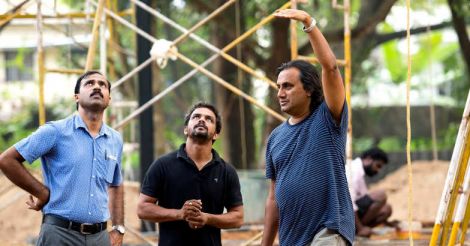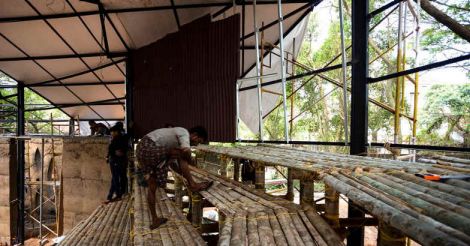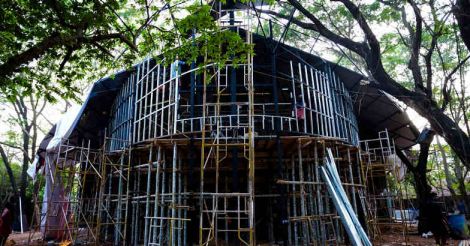Kochi: Rising from a clearing in the midst of trees in Cabral Yard, the pavilion for Kochi-Muziris Biennale 2016 seems, at once, a part of and separate from its setting.
Designed by architect and participating artist Tony Joseph to serve as both a host for Biennale events and an artwork in itself, the pavilion’s rugged exterior uses recycled debris and discarded materials from Fort Kochi. Inside the 4,157 sq ft structure, though, is an air-conditioned space that can accommodate 300 people and has a distinctly amphitheater feel.
“The design of the pavilion tries to accentuate our recollections and experiences of spaces, colors, textures, emotions and sensations and in the process, and rekindle our subconscious nostalgic references. It is also an exploration into recycling and reusing materials as a way to reduce the impact on the environment. Thus, there are a lot of tactile elements which coalesce to form the design.” Joseph said.
 The Pavilion’s rugged exterior uses recycled debris and discarded materials from Fort Kochi. Courtesy: Kochi Biennale Foundation
The Pavilion’s rugged exterior uses recycled debris and discarded materials from Fort Kochi. Courtesy: Kochi Biennale FoundationThe design concept evolves from the context of the site, drawing parallels to the surrounding fabric of Fort Kochi, with its stock of dilapidated godowns and adaptively reused structures.
The ‘debris wall’ uses broken brickbats and stones, along with the earth dug from the site itself. Old sarees, collected from local households, intertwine with the trusses – made from reclaimed wood – that support the roof to create an ever shifting pattern of light and colours.
Bringing up the rear are temporary wooden galleries made of areca-nut planks. Along the floor are rakings finished in a combination of lime and sand, which rise up unobtrusively toward the rear providing a clear line of sight to the raised stage at the front.
The multi-purpose stage will feature performances, poetry recitals, seminars, film screenings and competitions. The entire rear side of the stage can be opened up, transitioning to the exterior seating.
“The gallery-like seating inside is commonly found in the rural festivals and sporting venues of Kerala. The overall design of the pavilion as well as the interiors reference a lot of the regional elements to create the contextual rootedness,” Joseph said.
 The 4,157 sq ft Biennale pavilion can accommodate 300 people and has a distinctly amphitheater feel. Courtesy: Kochi Biennale Foundation
The 4,157 sq ft Biennale pavilion can accommodate 300 people and has a distinctly amphitheater feel. Courtesy: Kochi Biennale Foundation
“For instance, one enters the pavilion by moving through the transitionary space of the ‘Muttam’, a unique construct of traditional Kerala homes, down into the womb of the earth and enters into the powerful interior space which indirectly references a traditional ‘Kalari’. The elements in the interiors further add to this sense of nostalgia by alluding to ideas from our cultural history, which are gradually being lost in the progress of time. Thus, the art is not separate from the architecture, but is integrally intertwined in the Pavilion,” he added.
Adding an element of public participation is an ongoing competition for young architects and designers to come up with a concept chair fashioned from old wooden chairs to be used for the seating at the pavilion.
























